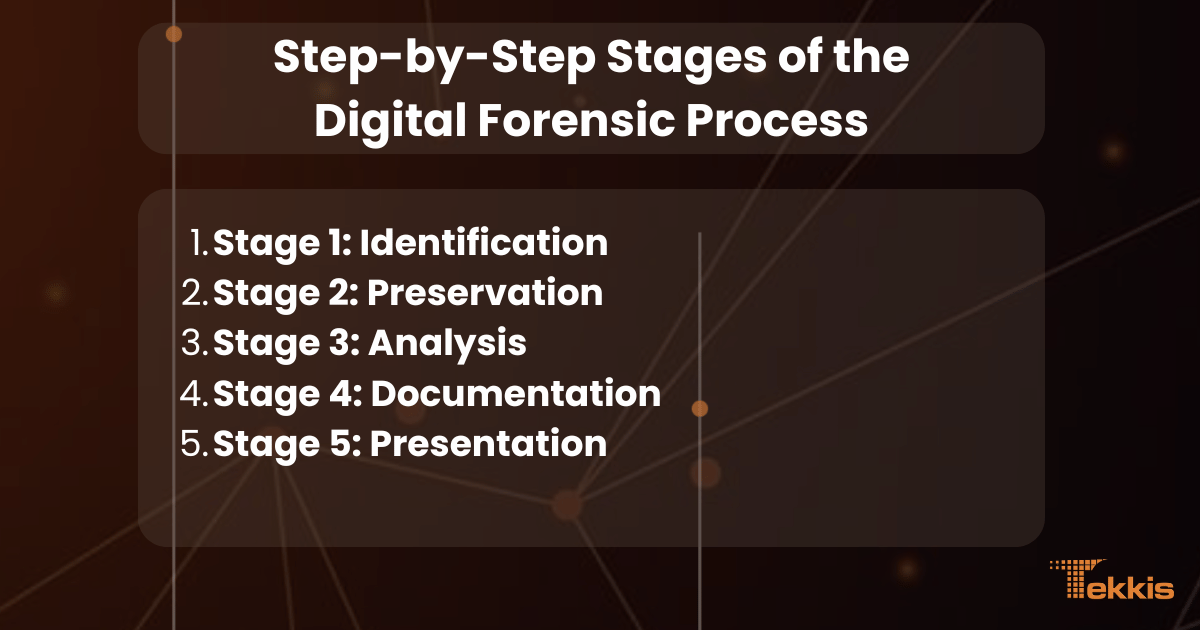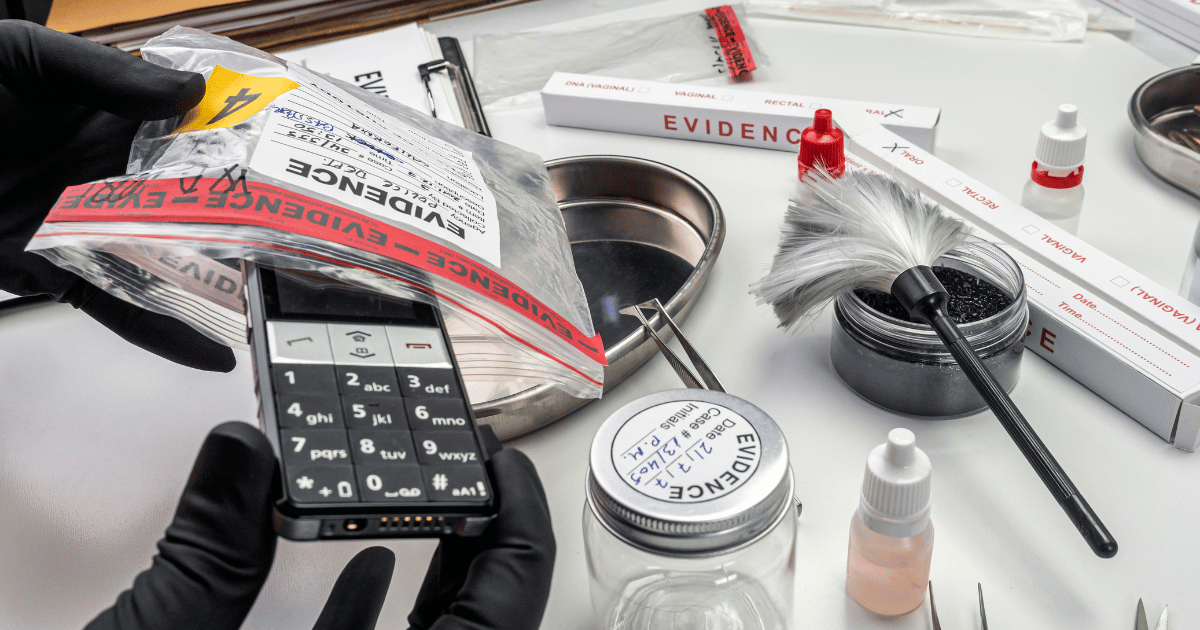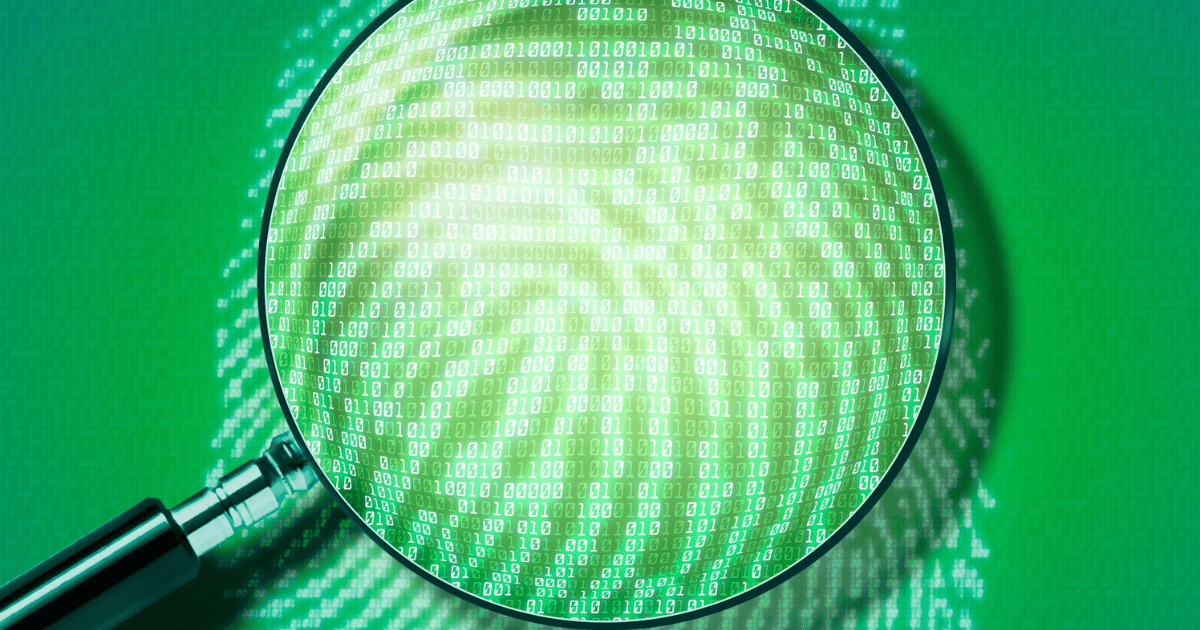What is the Digital Forensic Process?
The digital forensic process is a methodical approach to investigating and recovering data from digital devices while keeping its integrity intact for legal proceedings. At its core, digital forensics applies scientific methods to identify, collect, analyze, and preserve electronic evidence from digital sources.
So what exactly is digital forensics? It's the branch of forensic science that deals with recovering and investigating material found in digital devices. This field bridges the gap between technical know-how and legal requirements, making sure digital evidence holds up in courtrooms and investigations.
The definition of digital forensics has grown significantly over time. While it initially focused mainly on computer hard drives, it now covers smartphones, cloud storage, Internet of Things devices, and basically any technology that stores or transmits data. This expansion reflects our increasingly connected digital world.
According to the National Institute of Standards and Technology (NIST) Special Publication 800-86, a proper digital forensic investigation follows four basic phases: collection, examination, analysis, and reporting. The industry has expanded this framework into the five-stage model we'll explore in this article.
Enhance your digital investigations with Tekkis! Our cutting-edge digital forensics tools ensure you recover crucial evidence efficiently and maintain the integrity of your data. Contact us today to streamline your forensic processes and elevate your case outcomes!
Also Read:
"The greatest challenge in digital forensics today isn't finding evidence – it's ensuring that evidence remains intact and defensible throughout the entire investigative process." – Dr. Eoghan Casey, Digital Forensics Expert and Author of "Digital Evidence and Computer Crime"

Step-by-Step Stages of the Digital Forensic Process
The digital forensic process follows a careful workflow designed to protect the integrity and admissibility of evidence. Understanding these sequential steps is vital for conducting thorough, defensible investigations. Each stage builds on the previous one, creating a comprehensive process that stands up to scrutiny in both corporate and legal settings.
Stage 1: Identification
Key Concepts in Identification
Identification is the crucial first step where investigators determine potential sources of relevant evidence. This involves cataloging all digital devices that might contain evidence—from obvious ones like computers, servers, and smartphones to often overlooked items like IoT devices, cloud storage accounts, and external drives.
According to the ISO/IEC 27037:2012 standard, which provides guidelines for digital evidence identification, proper identification requires:
- Recognizing potential digital evidence
- Documenting the entire scene including all digital devices
- Prioritizing collection order based on evidence volatility
- Identifying both obvious and non-obvious sources of evidence
During this stage, investigators develop an initial understanding of the incident scope, timeline, and potential evidence locations. They need to consider both active data (readily accessible files) and latent data (deleted files, logs, or metadata) that could provide valuable insights.
"In over 15 years of conducting digital investigations, I've found that the identification phase is where cases are often won or lost. Missing a single device or account can create critical gaps in your evidence timeline." – Sarah Johnson, Chief Forensic Examiner at Digital Discovery Partners
Common Challenges in Identification
Identifying digital evidence comes with numerous challenges that can derail an investigation if not properly handled:
- Expanding Scope: Evidence might be scattered across multiple devices, cloud platforms, and jurisdictions—sometimes spanning different countries with varying legal frameworks.
- Encryption Barriers: Protected data needs to be identified early so appropriate resources for accessing it can be planned. According to forensic experts, encountering full-disk encryption has jumped by over 40% in the past five years.
- Volatile Data Loss: Memory-resident evidence can vanish within seconds if devices are mishandled. As one experienced investigator puts it, "A simple reboot can destroy more evidence than years of deletion."
- Anti-Forensic Techniques: Spotting evidence that's been deliberately hidden through encryption, steganography, or data wiping requires specialized identification approaches.
- Resource Constraints: Figuring out which devices are truly relevant versus those that would waste valuable resources requires both technical knowledge and investigative experience.
Stage 2: Preservation
Methods to Preserve Digital Evidence
Preservation ensures that digital evidence stays unchanged throughout the investigation. According to NIST Special Publication 800-86, "Even actions taken to inspect the contents of the media may alter the evidence." This highlights the critical importance of proper preservation techniques.
The fundamental principle is creating forensically sound duplicates of the original data using write-blockers and specialized imaging tools that prevent any modifications to the source media.
Standard preservation methods include:
- Bit-by-Bit Imaging: Creating complete forensic images that capture every sector of storage media, including deleted files, slack space, and unallocated clusters
- Live Memory Acquisition: running systems where powering down would lose volatile data, memory dumps must be captured to preserve running processes, network connections, and temporary data
- Cloud Preservation: API-based collection or specialized tools designed for particular cloud platforms
- Mobile Device Acquisition: Specialized techniques that address unique operating systems, encryption implementations, and physical interfaces
"The most common preservation error I see is investigators rushing to examine evidence before properly documenting and imaging it. Remember: you only get one chance to collect volatile data correctly." – Michael Rodriguez, Former FBI Cyber Division Forensic Examiner
Understanding Chain of Custody
The chain of custody forms the backbone of evidence integrity in digital forensics. This unbroken documentation trail tracks every interaction with digital evidence from collection through analysis and presentation.
The Scientific Working Group on Digital Evidence (SWGDE) best practices emphasize that proper chain of custody records must include:
- Who handled the evidence
- When they accessed it (date and time)
- Where it was stored
- What actions were performed
- Why these actions were necessary
- How the evidence was transferred
Each transfer of custody must be documented with signatures, timestamps, and reasons for the transfer.
Practical Challenges in Preservation
Digital evidence preservation faces several practical hurdles that investigators regularly encounter:
- Data Volumes: Modern storage devices can contain terabytes of data, making full forensic imaging time-consuming and storage-intensive.
- Encryption Obstacles: Full-disk encryption can prevent proper imaging without appropriate credentials or decryption approaches.
- Remote Collection Issues: Cloud-based evidence often requires preserving data that exists in multiple jurisdictions with different legal requirements.
- Rapidly Evolving Technology: New device types and storage methods continually emerge, requiring regular updates to preservation techniques and tools.
- Legal Authority Limitations: Investigators must operate within the scope of their legal authority, which may restrict what can be preserved and how.
Stage 3: Analysis
Techniques for Analyzing Digital Data
Analysis is the investigative heart of the digital forensic process, where preserved evidence is methodically examined to extract relevant information. ISO/IEC 27042:2015 provides guidelines for the analysis and interpretation of digital evidence, emphasizing structured approaches to maintain evidential value.
Key analytical techniques include:
- Timeline Analysis: Reconstructs the chronology of events by connecting timestamps from various sources—file creation dates, log entries, and metadata—to build a comprehensive picture of activities.
- File System Analysis: Uncovers how data is organized, identifying deleted files, hidden partitions, or suspicious file manipulations.
- Content Analysis: Examines file contents through keyword searches, pattern matching, and context examination to identify relevant information.
- Network Forensics: Analyzes traffic captures, connection logs, and protocol data to understand communications between systems.
- Memory Forensics: Examines RAM snapshots to reveal running processes, malware, encryption keys, and other volatile data that disappears when devices power down.
"The analysis phase is where art meets science in digital forensics. Tools can extract the data, but it takes investigative intuition developed through experience to recognize the significance of subtle digital artifacts." – Dr. Lisa Turner, Digital Forensics Professor, Cybersecurity Institute
Forensic Analysis Tools and their Applications
The digital forensic process relies heavily on specialized tools designed for different analysis requirements. When selecting tools, investigators should consider the comparative strengths and limitations:
| Tool Category | Popular Examples | strengths | Limitations |
|---|---|---|---|
| Comprehensive Suites | EnCase, FTK, X-Ways | All-in-one solution, strong court acceptance | High cost, steep learning curve |
| Open-Source Tools | Autopsy, The Sleuth Kit | Cost-effective, customizable | May lack technical support, fewer automated features |
| Mobile Forensics | Cellebrite UFED, Oxygen | Specialized for mobile extraction, regularly updated for new devices | Device-specific challenges, may not support all models |
| Memory Analysis | Volatility, Redline | Captures volatile data invisible to disk forensics | Complex to use, requires specialized knowledge |
| Network Analysis | Wireshark, NetworkMiner | Excellent protocol analysis, reconstructs network evidence | Limited to captured traffic only, encryption challenges |
Modern forensic tools increasingly use artificial intelligence to handle massive datasets, automatically categorizing files, identifying patterns, and flagging anomalies that might otherwise be missed.
Practical Challenges in Analysis
Digital forensic analysts face numerous practical challenges that require adaptation and problem-solving:
- Data Volume Overload: Investigations routinely involve terabytes of data, making comprehensive manual review impossible. This "data deluge" necessitates intelligent search and filtering techniques.
- Encryption Barriers: Encountering encrypted files, volumes, or communications may prevent access to critical evidence without proper keys or decryption methods.
- Anti-Forensic Techniques: Sophisticated actors may employ tools to wipe artifacts, plant false evidence, or obscure digital trails, requiring additional scrutiny.
- Evolving Technology: New applications and services constantly emerge, creating unfamiliar artifacts that require research to properly interpret.
- Time Constraints: Investigations often operate under tight deadlines, forcing analysts to prioritize what might yield the most relevant evidence quickly.
Stage 4: Documentation
Best Practices for Recording Findings
Documentation transforms forensic findings into comprehensible, defensible reports that stand up to scrutiny. According to NIST guidelines, effective documentation should provide enough information to allow another examiner to repeat the same process and reach the same conclusions.
Best practices include:
- Keeping detailed notes throughout the investigation
- Clearly distinguishing between factual observations and analyst interpretations
- Using visual aids—screenshots, diagrams, and timelines—to communicate complex digital relationships
- Documenting tools used, their versions, and validation methods
- Recording both positive findings and negative results to demonstrate thoroughness
"The most technically brilliant forensic analysis is worthless if it can't be clearly communicated and understood by decision-makers. Documentation isn't just record-keeping—it's translating technical findings into actionable intelligence." – James Chen, Lead Forensic Examiner, Cyber Incident Response Team
Legal Considerations in Documentation
Documentation must meet stringent legal requirements to remain admissible in court proceedings. Reports should be written assuming they will face legal challenges, maintaining objectivity and avoiding speculative conclusions or biased language.
The Association of Chief Police Officers (ACPO) Good Practice Guide, widely used in the UK and internationally, emphasizes four principles that should be reflected in documentation:
- No action should change original evidence
- Where necessary to access original data, the examiner must be competent and able to explain their actions
- An audit trail of all processes should be created and preserved
- The person in charge of the investigation bears overall responsibility for ensuring these principles are adhered to
Practical Challenges in Documentation
Documentation in digital forensics presents several practical challenges:
- Technical Translation: Explaining complex technical concepts in language accessible to non-technical stakeholders without sacrificing accuracy.
- Scope Management: Determining the appropriate level of detail—too much information overwhelms readers while too little undermines conclusions.
- Consistency: Maintaining consistent terminology and formatting throughout lengthy investigations involving multiple examiners.
- Evolving Case Parameters: Adapting documentation when new evidence emerges or investigative focus shifts.
- Tool Limitations: Acknowledging and explaining the limitations of forensic tools and their potential impact on findings.
Stage 5: Presentation
Presenting Digital Evidence in Legal Contexts
The presentation stage transforms complex technical findings into compelling, understandable narratives for judges, juries, executives, or other decision-makers. This process must follow evidentiary rules while effectively communicating key findings.
According to the Scientific Working Group on Digital Evidence (SWGDE), effective presentation includes:
- Distilling technical findings into clear narratives that emphasize significance
- Translating technical concepts into accessible analogies
- Using visual evidence effectively—showing screenshots, timelines, and relationship maps
- Preparing demonstrations that clearly illustrate technical concepts
- Anticipating and preparing for cross-examination challenges
"I've seen brilliant technical cases fail in court simply because the examiner couldn't effectively explain their findings to a non-technical jury. The ability to translate complex digital evidence into relatable concepts is as important as the technical analysis itself." – Katherine Reynolds, Former Prosecutor specializing in cybercrime cases
Essential Skills for Effective Presentation
Successfully presenting digital forensic evidence requires a unique blend of technical expertise and communication skills:
- Clear explanation of technical concepts without excessive jargon
- Confident speaking that builds credibility with decision-makers
- Ability to adapt explanations to different audience technical levels
- Visual communication skills to effectively use demonstrative exhibits
- Professional objectivity that focuses on evidence rather than opinions
Practical Challenges in Presentation
Digital evidence presentation faces several practical challenges:
- Knowledge Gap: Bridging the technical understanding gap between forensic specialists and non-technical audiences.
- Complexity Simplification: Simplifying complex technical processes without oversimplification that misrepresents the evidence.
- Opposing Expert Challenges: Preparing for challenges from opposing experts who may present alternative interpretations.
- Technology Limitations: Managing technical demonstrations in courtroom environments with limited technical resources.
- Time Constraints: Condensing months of investigation into concise testimony with strict time limitations.
Essential Tools and Technologies in Digital Forensics
The landscape of digital forensics technologies constantly evolves to meet the challenges of increasingly sophisticated digital environments. As storage capacities grow, encryption becomes more prevalent, and new device types emerge, forensic tools must adapt to stay effective.
Overview of Common Forensic Tools
The foundation of digital forensics rests on several categories of essential tools that have become standard across the industry:
| Tool Category | Popular Solutions | Key Capabilities | Best Use Cases |
|---|---|---|---|
| Disk Imaging | FTK Imager, dd, Guymager | Creates forensically sound duplicates, implements write-blocking, verifies image integrity | Initial evidence preservation, creating working copies |
| Comprehensive Suites | EnCase, FTK, X-Ways | File recovery, data carving, search/filter, timeline analysis, reporting | Complex investigations requiring multiple types of analysis |
| Mobile Forensics | Cellebrite UFED, Oxygen Forensic | Extraction from locked devices, app data parsing, deleted data recovery | Smartphone and tablet investigations |
| Memory Analysis | Volatility, Redline, DumpIt | Process examination, artifact recovery, malware detection | Capturing volatile data, malware investigation |
| Network Forensics | Wireshark, NetworkMiner | Packet capture, traffic analysis, connection mapping | Network intrusion investigations |
| Email Analysis | Aid4Mail, EmailTrackerPro | Message extraction, header analysis, attachment recovery | Email-focused investigations |
| Password Recovery | Passware, Hashcat | Dictionary attacks, brute force capabilities, specialized cracking | Accessing encrypted evidence |
"No single tool solves every case. The most effective examiners maintain proficiency across multiple tools and know exactly which one to deploy based on the specific evidence they're examining." – Robert Osgood, Former FBI Computer Analysis Response Team Leader
Advanced Technologies Shaping Digital Forensics
The future of digital forensics is being shaped by revolutionary technologies that address emerging challenges:
Artificial Intelligence and Machine Learning
AI-powered forensic tools can automatically classify files, detect patterns, identify anomalies, and even recognize objects within images. These systems help prioritize evidence in massive datasets, allowing investigators to focus on the most promising leads first. As one forensic lab director notes, "AI isn't replacing analysts—it's helping them focus their expertise where it matters most."
Cloud Forensics
With the rise of cloud computing, specialized tools have emerged to address distributed evidence. According to recent research, cloud-based evidence appears in over 60% of corporate investigations. Tools like Office 365 E-Discovery and AWS CloudTrail forensics allow investigators to capture snapshots of virtual environments and extract logs that might otherwise be inaccessible.
Memory Forensics for Fileless Malware
The rise of memory-only malware has made RAM analysis increasingly crucial. According to security researchers, memory-resident malware like Duqu 2.0 exploits zero-day vulnerabilities and resides only in memory, requiring advanced forensic memory analysis to detect. Tools like Volatility and Rekall allow investigators to extract this volatile evidence before it disappears.
IoT Device Forensics
As everyday objects become evidence sources, specialized approaches are emerging to extract data from diverse IoT devices. These investigations face significant challenges due to the diversity of device types, operating systems, and data formats. Forensic researchers are developing standardized approaches to this fragmented landscape, focusing on common underlying technologies.
Emerging Challenges and Solutions
Digital forensics faces several emerging challenges that are driving innovation in tools and methodologies:
Encryption
End-to-end encrypted communications and full-disk encryption present major obstacles. While direct decryption is often impossible, investigators are developing alternative approaches:
- Memory forensics to access decrypted data in RAM
- Leveraging implementation flaws or side-channel attacks
- Legal frameworks for lawful access to encrypted data
Data Volume
The sheer volume of data in modern investigations can overwhelm traditional forensic approaches:
- AI-powered analytics to identify relevant evidence automatically
- Distributed processing frameworks to handle terabytes of data
- Targeted collection strategies that focus on the most valuable evidence sources
Anti-Forensic Techniques
Sophisticated actors increasingly use techniques to thwart forensic analysis:
- Advanced timestamp analysis to detect tampering
- Cross-validation across multiple evidence sources to identify inconsistencies
- Memory analysis to bypass disk-level anti-forensic measures

Digital Forensics Case Studies and Applications
The theoretical frameworks and technologies of digital forensics come alive when applied to real-world situations. Looking at digital forensics examples provides valuable insights into how these methodologies work in practice and why digital forensics matters across various sectors, from criminal justice to corporate governance.
Notable Case Studies Demonstrating Forensic Techniques
BTK Killer Case: Dennis Rader, who had evaded police for 30 years, was finally caught in 2005 after sending police a floppy disk. Forensic analysis revealed metadata in a deleted Microsoft Word document containing information about Rader's church, where he served as president. This case shows how even seemingly minor digital artifacts can provide crucial investigative breakthroughs.
The Silk Road Investigation: When investigating this notorious dark web marketplace, investigators faced the challenge of identifying the site's administrator, known only as "Dread Pirate Roberts." Through sophisticated digital forensic techniques including packet analysis and blockchain transaction tracing, authorities identified Ross Ulbricht as the operator. The investigation demonstrated how forensic persistence and technical expertise could overcome anonymization tools like Tor and cryptocurrency transactions designed to hide user identities.
Corporate Espionage Example: In one notable case, a departing employee at a technology company transferred proprietary source code to personal storage before joining a competitor. Digital forensic investigators recovered evidence by analyzing login records, file access logs, and deleted email fragments showing the deliberate theft. This case highlighted the importance of having forensic capabilities within corporate environments where evidence deteriorates quickly if not properly preserved
"What makes digital evidence so powerful is its persistence. Even when suspects believe they've covered their tracks, they rarely understand how many digital artifacts their actions create across multiple systems." – Marcus Thompson, Corporate Forensics Specialist
When and Why Businesses Use Digital Forensics
Internal Fraud Investigations
When financial irregularities pop up, forensic analysis can reveal incriminating evidence like altered accounting files, suspicious emails, or unusual access patterns to financial systems. The ability to reconstruct user activities across corporate networks shows why digital forensics matters for establishing timelines of suspicious activities and connecting them to specific employees.
Data Breach Response
After security incidents, organizations need to figure out what data was accessed, how attackers got in, and whether backdoors remain. Digital forensics provides these critical insights through disk imaging, memory analysis, log examination, and network traffic review. This process helps businesses meet regulatory notification requirements by determining exactly what information was compromised.
Intellectual Property Protection
When key employees leave for competitors, forensic analysis can detect unauthorized file transfers, suspicious printing activities, or abnormal access patterns in the days and weeks before resignation. These investigations often include examining browser history, email communications, and external device connections to identify the theft of valuable corporate information.
Litigation Support
Digital evidence increasingly factors into employment disputes, contract disagreements, and many other civil proceedings. Corporate legal departments use forensic expertise to preserve relevant electronic evidence, authenticate digital documents, and resist spoliation claims. The ability to demonstrate proper evidence handling often proves as important as the evidence itself in these contexts.
Forensic Readiness: Preparing for Inevitable Incidents
Organizations are increasingly adopting forensic readiness programs that prepare them for effective investigations before incidents occur. According to digital forensics experts, proper preparation can cut investigation costs by up to 50% and significantly improve outcomes.
A comprehensive forensic readiness program includes:
- Proper Logging and Monitoring: Setting up systems to capture forensically valuable information before incidents occur
- Evidence Preservation Protocols: Established procedures for first responders to preserve volatile evidence
- Staff Training: Ensuring IT and security personnel understand basic evidence handling
- Tool Preparation: Having appropriate forensic software and hardware available before needed
- Legal Guidance: Advance consultation with legal counsel regarding evidence collection requirements
- Chain of Custody Documentation: Standardized forms and procedures for maintaining evidence integrity
"The worst time to develop your forensic capabilities is during a crisis. Organizations that invest in forensic readiness respond more effectively when incidents occur and often prevent them from escalating into full-scale breaches." – David Cowen, Principal of The SANS Institute's FOR500: Windows Forensic Analysis course
Use this checklist to assess your organization's preparedness for digital investigations:
- Have you identified critical systems that would require investigation during incidents?
- Are logging and monitoring systems configured to capture forensically valuable information?
- Do you have established procedures for secure evidence collection and preservation?
- Are staff trained on basic digital evidence handling procedures?
- Have you established relationships with external forensic specialists if needed?
- Do you maintain appropriate forensic software and hardware tools?
- Are legal requirements for evidence collection and handling documented?
- Do you have standardized chain of custody procedures and documentation?
- Have you conducted tabletop exercises to test your forensic response capabilities?
- Is there a clear escalation path for potential incidents requiring forensic investigation?

Conclusion
The digital forensic process is essential for modern investigations in our digital world. Its five-stage methodology—identification, preservation, analysis, documentation, and presentation—ensures evidence integrity and supports investigators in revealing the digital truth. By adhering to industry standards like NIST SP 800-86 and ISO/IEC 27037, forensic practitioners can transform fragmented digital artifacts into compelling evidence. As technology evolves, so too will the tools and techniques of digital forensics, presenting challenges and opportunities. Embracing a proactive forensic readiness checklist can significantly enhance an organization’s response capabilities.
If you're struggling to manage digital evidence or worried about the integrity of your investigations in this rapidly changing landscape, Tekkis Cybersecurity can help. Our expert guidance and tailored solutions are designed to address your specific challenges and ensure your digital forensic strategies are robust and effective. Reach out to us today to safeguard your organization's digital integrity!



